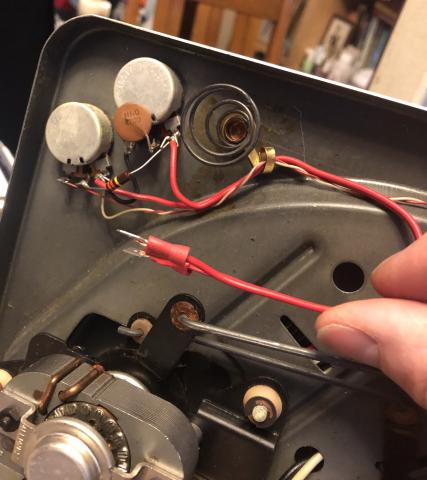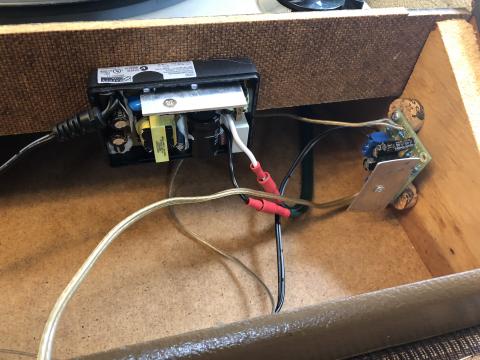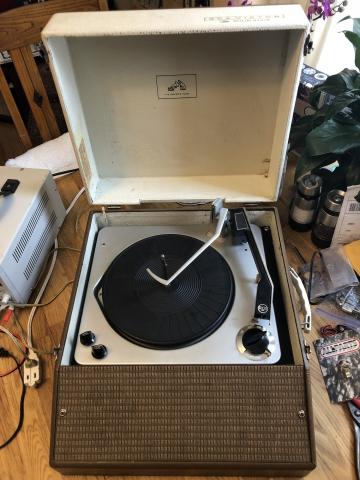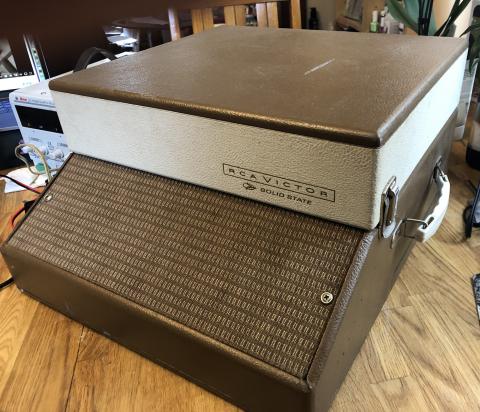This is a 1964 RCA VGA11T record changer that i found at our local surplus store:
As advertised, it powered up and turned the platter, but no audio signal. I was looking for a project and had $20, so it came home with me. Having recently tuned up an old Dual automatic turntable for sale i was happy to not have to get into the mechanicals of a record changer.
In some initial testing with a meter, the cartridge didn't seem to be putting out any signal, which should be around 1 volt for this Astat 346 cartridge (from online research), so it should show something on meter. I found a good deal on an NOS unit online with a LP/78 flip needle. Unfortunately, installing the cartridge did nothing for the overall audio output, so I dug in further.
I'm no electronics expert, but tracing the wiring I realized there didn't seem to be any power going to the amp circuit. With no schematic to work from I decided it would be easier to try to replace the amp entirely than try to fix it with my limited knowledge and test equipment.
At least I was able to trace the signal path and tap into the input line. The 2 very thin wires here are coming in from the cartridge, the signal goes through the tone and volume pots, then out to the heavier red wire and back to the amp. By tapping in here I can use the original knobs & position and have volume control. I clipped that and added some connectors for easier testing.
I did a fair amount of research about the various small amp circuits available, and I'm still certainly no expert. I ended up with a small amp kit based on a LM1875T chip that I had to assembly myself, but only cost $6. It's rated for 20W, which is probably way more than needed for a single 4" speaker, but I figured the extra overhead might help, not having a separate pre-amp.
I clipped the new circuit together for testing to see if the new amp would provide enough power and a decent sound. It worked great! I'm testing it here with a 78 disc. The amp board is rated up to 25 volts, so I tried it at different levels to see how different voltages worked. There wasn't any real difference in performance from 6-18 volts, so I dug through my pile of wall warts to see what might be a good fit.
Happily, the old style crystal cartridge puts out a strong signal with great tone balance, so the sound and volume was spot on, and didn't overload the speaker. Again, I'm not expert, but it looks like newer MM or MC cartridge would require a preamp to get the right RIAA tone curve before the standard power amp. This set up has a very small hum at idle, but I'm just going to live with it.
I chose a fairly lightweight wall transformer putting out 12VDC and 1 amp, and tested it in place of the power supply to confirm before pulling it apart. With the back of the case off I could solder in the power leads (in place of the wall plug) and finalize the input & output wiring.
The power supply was glued in to the case bottom, so it hot glued that to the player case, and the amp board screwed in to the side with some cork spacers. There's easily room to fit both under the speaker board and nothing is visible once the cover it back on. I added a couple of staples to keep the wires from flopping around.
Here's the final assembly, everything buttoned up and working. I tapped into the main unit power after the on/off switch, which is triggered by the Manual/Automatic switch at the lower right corner. That way the amp is powered on at the same time as the turntable motor. All controls work just like the original did, just going through some different guts.
Here's a view all closed up and ready for travel. This is going to be really nice for back yard listening and maybe even some camping trips.






